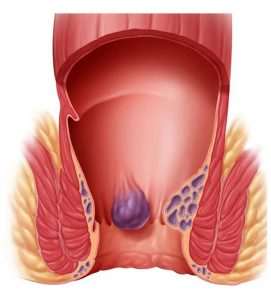What are hemorrhoids
Hemorrhoids are composed of small arteries and veins, of many arterio-venous anastomoses, creating vascular masses that share many functional properties with the erectile tissue.
These masses are located in the lower part of the colon and anus, in a circular fashion, creating two hemorrhoidal plexuses, the internal and external hemorrhoids. Internal hemorrhoids arise from the internal hemorrhoidal plexus, while external hemorrhoids arise from the external plexus (see album).
These two anatomical structures are present under normal conditions in all humans and contribute to the mechanism of continence, i.e. better sealing of the anus and control of stools. Therefore, normal hemorrhoids are not a disease but part of our body. But when the hemorrhoids become irritated, swollen and inflamed, causing unpleasant symptoms for the patient, then we use the term ‘hemorrhoidal disease’. In our everyday life when we say I have hemorrhoids, we mean that I have abnormal hemorrhoids.
How common are hemorrhoids?
Hemorrhoidal disease is a condition that manifests itself in an unsuspected time and in a very large percentage of the population. Two-thirds of healthy people who undergo clinical examinations are diagnosed with hemorrhoids. The cause of hemorrhoids is unknown, but the factors that seem to predispose and increase the risk of hemorrhoidal disease are the following:
- Chronic constipation
- Pregnancy/childbirth
- Heavy work that contributes to frequent increase of intra-abdominal pressure
- Genetic predisposition
- Sedentary life and obesity
- Prolonged and frequent standing
- Poor hygiene of the anal area
Hemorrhoids – Is it possible to prevent them?
The best way to prevent hemorrhoids from becoming pathological is to have normal bowel movements. This depends on the diet, but also on timely visits to the toilet – that is, going whenever the need arises. Feces are best eliminated when soft, with little stress or effort exerted.
Exercise, walking and eating a high-fiber diet helps reduce constipation, softening stools and facilitating their elimination.
A diet rich in fiber includes:
- Beans
- Black-eyed peas
- Kiwifruits
- Brown rice
- Corn
- Wholegrain bread
- Avocados
- Oatmeal
- Raspberries
- Pears
- Peas
- Broccoli
- Apples
- Almonds
- Whole-grain pasta
Long stays in the toilet should be avoided, because it is a habit that “spoils” the gut. The necessary time to complete defecation is 5 to 10 minutes. Longer duration is excessive and when done for a long time, it contributes decisively to the swelling and prolapse of the hemorrhoids.
Hygiene of the area and washing with plenty of lukewarm or warm water at the end of each defecation also plays an important role.
Hemorrhoids do not appear overnight. In order to prevent or reverse it in time, all you have to do is to observe the above, avoid constipation, the time spent on the toilet and the hygiene of the area (washing with plenty of lukewarm or warm water at the end of each bowel movement).



